Selling on Walmart Vs Amazon

Selling on Walmart Vs Amazon
While Amazon can be an excellent platform to begin selling online, Walmart may present advantages as a marketplace to start. There are fewer sellers here and thus less of an investment is required in getting started with Walmart selling.
However, being accepted on the Walmart marketplace takes longer and requires proper pricing strategies and strict adherence to their rules regarding product prices.
Less Competition
Walmart stands out as an established traditional retailer with strong branding presence, increasing the likelihood that potential buyers will see your product. Furthermore, due to their application process requiring proof of ownership and other qualifications for IP infringement claims. Furthermore, due to less intense promotions on Walmart’s platform it offers greater product exposure on site as well as offering potential opportunities to sell in brick-and-mortar stores as well.
Walmart provides sellers with several incentives, such as waived storage fees during peak shopping season and offering several shipping options that meet buyers’ diverse needs. In-store pick-up for certain items makes purchases quicker for impulse shoppers while referral fees and fulfillment fees are significantly lower than those of Amazon.
Both platforms offer sellers several benefits, yet it’s essential for them to understand the differences in order to maximize sales. Selecting the most suitable marketplace will enable you to optimize product listings, manage inventory efficiently, reduce costs and remain competitive in this ever-evolving digital space.
With more than two billion US site visits every month, Amazon holds a commanding lead over other e-commerce platforms. But Walmart marketplace is rapidly catching up and could soon surpass Amazon in terms of both traffic and revenue. With so many opportunities for brands, establishing themselves on both sites may help reach more customers and reach higher conversions. This guide details best practices for selling on Amazon and Walmart to create happy, loyal buyers and increase conversion rates. The guide addresses various topics, such as shipping, fees and listing practices. It’s designed for new sellers as well as experienced ones looking to move to another marketplace; with its easy-to-follow format and wealth of valuable information that can help strengthen your e-commerce business. Should you have any inquiries please don’t hesitate to reach out – we are more than happy to assist!
Less Costs
Walmart Marketplace is an emerging player in eCommerce, providing both advantages and disadvantages for sellers. While its lack of experience could limit growth potential, Walmart Marketplace does offer lower fees than Amazon, making it more appealing for small businesses and startups. Furthermore, their brand equity can help sellers increase market share.
To qualify to sell on Walmart’s platform, companies must have been in business at least a year and possess a track record in selling online. Furthermore, annual revenue must reach at least $100,000, or $250,000 if public company. While this may seem like an ambitious goal to meet, established businesses would benefit greatly by selling both platforms simultaneously to maximize exposure and sales potential.
Sellers on Walmart can opt for either using Walmart’s fulfillment services or fulfilling orders themselves, with its fee structure differing slightly from Amazon in terms of referral and storage and fulfillment fees; Amazon caps its referral fees at 20% while Walmart doesn’t.
Walmart differentiates itself by setting strict standards of performance from its sellers. If they fail to meet them, their selling privileges are suspended on the platform; additionally, accurate categorization of products by sellers must also be observed as incorrect categorization can make it hard for customers to locate and buy specific items.
No matter if a company sells on Amazon or Walmart, having an effective online strategy that includes search engine optimization (SEO), quality content creation and clear product images is of equal importance. These factors can sway buyer behavior to purchase your product and can make or break your chance at landing the Buy Box.
Optimizing listings on both platforms requires using SEO keywords in both titles and descriptions, image alt texts, and image captions to increase discoverability for buyers searching on search engines like Google or Yahoo. In addition to using high-quality photos with professional lighting that ensure your products stand out, use photos that make an impressionable first impression – visuals have an immediate impact on purchasing decisions!
Less Risk
Amazon may be well-known and an innovative e-commerce platform, while Walmart boasts loyal customer bases of its own. If you want to expand your reach or increase sales, making sure that both platforms feature your products is important – each offers distinct customers while offering its own selling advantages and disadvantages.
One of the primary advantages of selling on Walmart over Amazon is reduced competition. Their invite-only marketplace ensures only sellers with proven track records can sell on its site, making it much simpler for sellers to rank higher in searches and increase sales on the platform.
Walmart charges sellers lower fees than Amazon when it comes to selling. While Amazon may charge referral fees of 6%-20% depending on the category, Walmart only levies up to 15% per sale transaction fee; though like Amazon they also assess fulfillment and storage fees according to product type.
Finally, having fewer sellers on Walmart means your ratings and product reviews can have more of an effect on buyers’ purchase decisions – this can be particularly valuable for new and emerging brands attempting to establish themselves in the marketplace.
Both marketplaces present an incredible opportunity for your e-commerce sales to expand and reach customers you wouldn’t otherwise reach. According to a recent Helium 10 study, grocery products are the fastest-growing segment of e-commerce sales – it’s no secret with Walmart and Amazon offering online grocery delivery services that this is true. Every marketplace presents unique advantages and disadvantages, making it essential for retailers to understand the varying seller practices in each one to maximize revenue potential. With both platforms boasting billions of monthly visitors, it’s vital for your business to take full advantage of this incredible market opportunity. One way to do this is to familiarize yourself with each marketplace’s specific shipping, fees and listing practices before entering an auction on either platform.
Less Time
Amazon may lead the pack when it comes to online sales, but Walmart is quickly making strides forward in this space. Walmart offers many advantages for sellers in terms of competition and fees as well as being able to attract more US customers than other platforms.
However, the Walmart marketplace ecommerce platform has stringent listing rules and an intensive approval process, making it a good option for established FBA businesses while newcomers may find it more difficult. Also, as Walmart only permits limited numbers of products per listing with unique identifiers assigned and requires that all listings adhere to price parity if found elsewhere (including shipping costs) they will be removed from their platform.
Though Walmart Marketplace competition may be minimal, sellers must still maintain good relations with buyers by maintaining high customer ratings and having full inventories. A repricing tool should also be utilized so as to compete on an equal playing field while adhering to all marketplace pricing rules.
Walmart’s marketplace boasts an excellent conversion and meeting buyer expectations rating, so retailers should take the time to optimize their listings with relevant keywords and captivating images to draw traffic and drive sales.
Walmart Marketplace presents an ideal opportunity for ecommerce brands looking to expand in 2021, with lower entry barriers and greater revenue potential than Amazon Marketplace. While the platform does have some drawbacks, it remains an integral player in online shopping landscape. Whatever marketplace best fits your brand or business, having presences on both is crucial – consumers are increasingly using marketplaces for research purposes, so making yourself known on both marketplaces ensures your reach can maximized and maximized opportunities and reach.
Step-by-step training on how to sell to retail chains!
We explain exactly how to do that and how to get started today. I’ve taught over 100,000 of companies over the years across the globe on how to get your products to the stores. And so we’re here to support you. Or please subscribe to our Youtube channel and or be on the lookout for additional training that we create.
We are here to expedite the process of generating revenue with your physical products and that’s what we’re all about. Take a look at our advanced training, live events, certification programs and so much more.
In this training, I will discuss some of the things to think about when approaching a retailer to sell your products and become a vendor. Hope it helps! 🙂
Karen Waksman,
Retail MBA
Questions? Contact Us!
1-855-Retail-2 (Call or Text)
Email: info@retailmba.com
Retail MBA provides a step-by-step formula on How to Sell to Major Retailers, Online Retailers, Smaller Retailers, Catalogs and More. No Experience Required! These solutions continue to convert for clients year-over-year! These are Time-Tested and Proven Strategies that we utilize ourselves when going after stores! Everything we teach, we test. Want access to these formulas? ANY one of our programs and coaching systems gives you access to them now. With that said…
Here are 5 Easy Ways to Work with Us:
1) Free Training – If You Would Like to Join Our Next FREE Webinar Training Called “Retail Chain Store Secrets – How to Sell to Major Retail Chains. No Experience Required” Then Sign Up NOW To Learn All About Selling into Retail Chains By Clicking Here!
2) Retail MBA Year Long Coaching and Training System – Our Year Long Coaching and Training System with Karen Waksman is POWERFUL! This is our most popular training and coaching system! We walk you through how to approach, pitch and sell to retail chains and we coach you along the way! Join us by Clicking Here!
3) Masterclass Intensives – Want to Join our Next 4 Week Elite Retail MBA Masterclass Intensive? These Intensives Are EPIC for people who Love Fast Paced Learning – Homework, Retail Coaching, Developing Your Strategy, Buyers Contacts and More! These Events Are Held Every Quarter. Join us by Clicking Here!
4) Done-for-You Program – If You Want Karen Waksman and Her Team to Reach Out to Your Top Dream Retail Chains On Your Behalf – And You Have a Retail-Ready Product, Check Out our Epic Done-For-You Service by Clicking Here!
5) In Person Events – If You Want to Learn LIVE and Meet Karen Waksman in Person at Our Next “America’s Next Retail Product: LIVE Event with Other Like-Minded Individuals in Beautiful San Diego, CA! We Would LOVE to Have You Join Us by Clicking Here!

Check Out Our Additional Blog Posts Here:
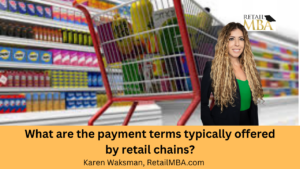
Retail Terms
Retail Terms – What are the payment terms typically offered by retail chains? Click Here to Learn More!
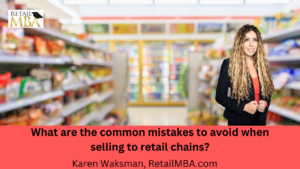
Retail Vendor
Retail Vendor – What are the common mistakes to avoid when selling to retail chains? Click Here to Learn More!
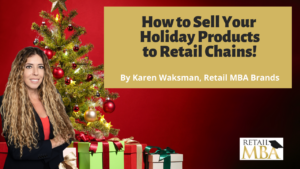
How to Sell Your Holiday Products to Retail Chains
New Training on How to Sell Your Holiday Products to Retail Chains

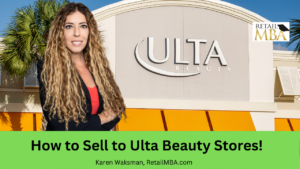
Ulta Beauty Vendor
Ulta Beauty Vendor – How to Sell to Ulta Beauty Stores. Click Here to Learn More!
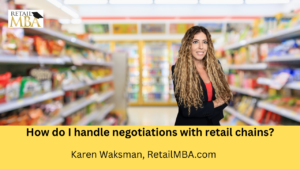
Retail Strategy
Retail Strategy – How do I handle negotiations with retail chains? Click Here to Learn More!

